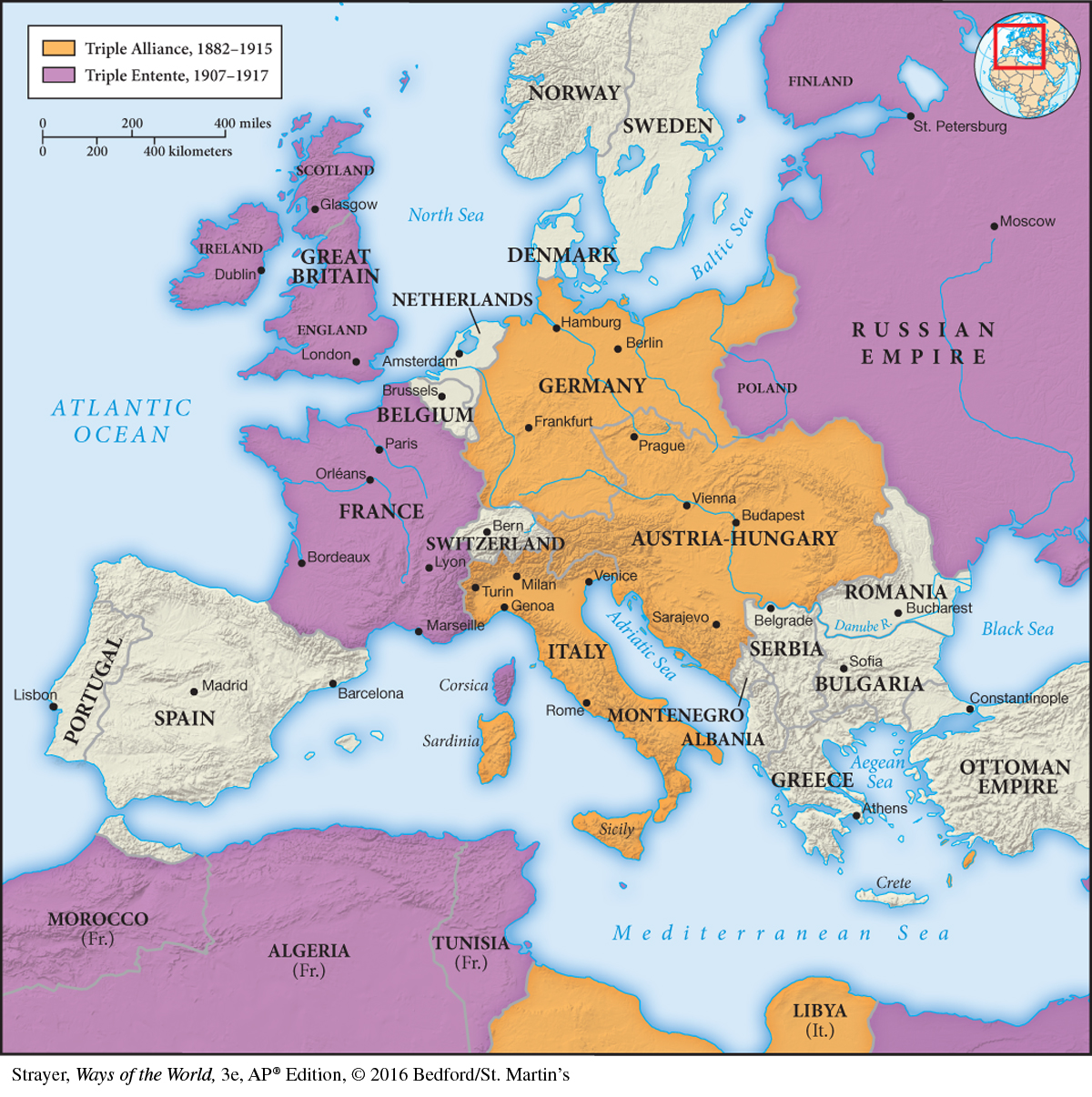An Accident Waiting to Happen
AP® EXAM TIP
Remember that like South Asia, Europe is rarely under one unified political system.
Europe’s modern transformation and its global ascendancy were certainly not accompanied by a growing unity or stability among its own peoples — quite the opposite. The most obvious division was among its competing states, a long-
883
That incident occurred on June 28, 1914, when a Serbian nationalist assassinated the heir to the Austro-Hungarian throne, Archduke Franz Ferdinand. To the rulers of Austria-Hungary, the surging nationalism of Serbian Slavs was a mortal threat to the cohesion of their fragile multinational empire, which included other Slavic peoples as well. Thus they determined to crush it. But behind Austria-Hungary lay its far more powerful ally, Germany, and behind tiny Serbia lay Russia, with its self-proclaimed mission of protecting other Slavic peoples. Allied to Russia were the French and the British. Thus a system of alliances intended to keep the peace created obligations that drew the Great Powers of Europe into a general war by early August 1914 (see Map 20.2).

Guided Reading Question
▪EXPLANATION
What aspects of Europe’s nineteenth-
884
AP® EXAM TIP
Keep a record of common factors that led to the three twentieth-century global wars.
The outbreak of that war was something of an accident, in that none of the major states planned or predicted the archduke’s assassination or deliberately sought a prolonged conflict, but the system of rigid alliances made Europe vulnerable to that kind of accident. Moreover, behind those alliances lay other factors that contributed to the eruption of war and shaped its character. One of them was a mounting popular nationalism (see “Industry and Empire” in Chapter 18). Slavic nationalism and Austro-
885

Also contributing to the war was an industrialized militarism. Europe’s armed rivalries had long ensured that military men enjoyed great social prestige, and most heads of state wore uniforms in public. All the Great Powers had substantial standing armies and, except for Britain, relied on conscription (compulsory military service) to staff them. One expression of the quickening rivalry among these states was a mounting arms race in naval warships, particularly between Germany and Britain. Furthermore, each of the major states had developed elaborate “war plans” that spelled out in great detail the movement of men and materials that should occur immediately upon the outbreak of war. Such plans created a hair-trigger mentality since each country had an incentive to strike first so that its particular strategy could be implemented on schedule and without interruption or surprise. The rapid industrialization of warfare had generated an array of novel weapons, including submarines, tanks, airplanes, poison gas, machine guns, and barbed wire. This new military technology contributed to the staggering casualties of the war, including some 10 million deaths, the vast majority male; perhaps twice that number were wounded, crippled, or disfigured. For countless women, as a result, there would be no husbands or children.
886
887
Europe’s imperial reach around the world likewise shaped the scope and conduct of the war. It funneled colonial troops and laborers by the hundreds of thousands into the war effort, with men from Africa, India, China, Southeast Asia, Australia, New Zealand, Canada, and South Africa taking part in the conflict. Battles raged in Africa and the South Pacific as British and French forces sought to seize German colonies abroad. Japan, allied with Britain, took various German possessions in China and the Pacific and made heavy demands on China itself. The Ottoman Empire, which entered the conflict on the side of Germany, became the site of intense military actions and witnessed an Arab revolt against Ottoman control. Finally, the United States, after initially seeking to avoid involvement in European quarrels, joined the war in 1917 when German submarines threatened American shipping. Some 2 million Americans took part in the first U.S. military action on European soil and helped turn the tide in favor of the British and French. Thus the war, though centered in Europe, had global dimensions and certainly merited its title as a “world war.”